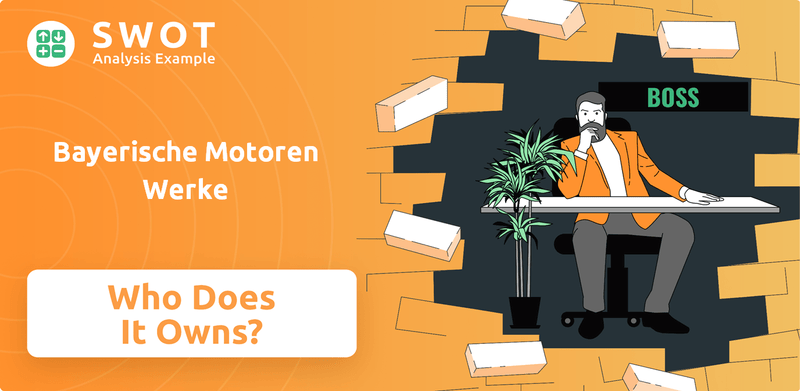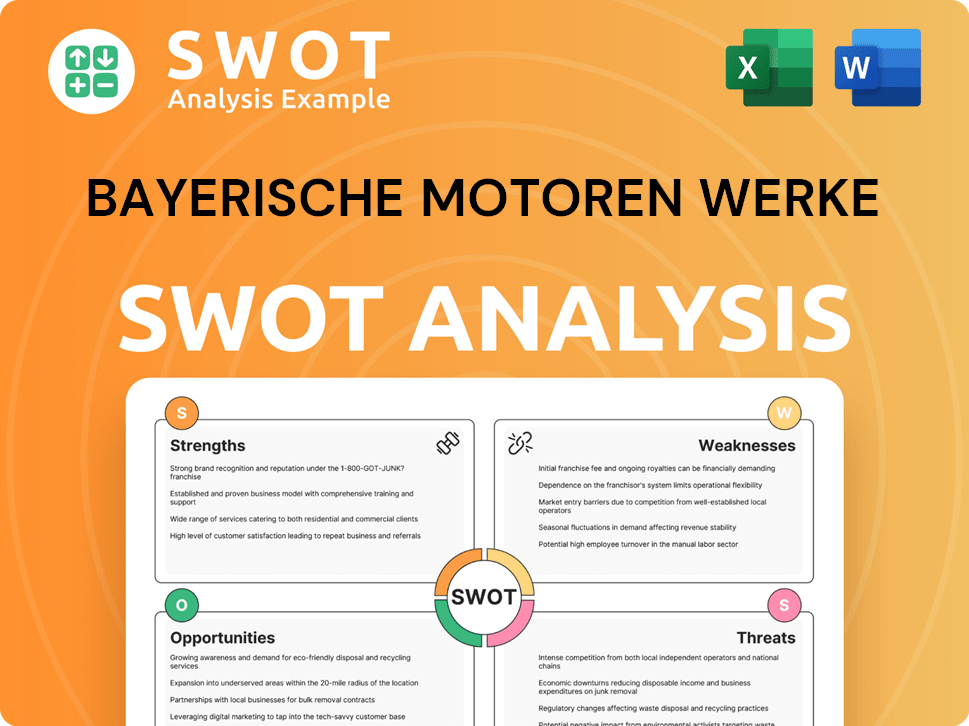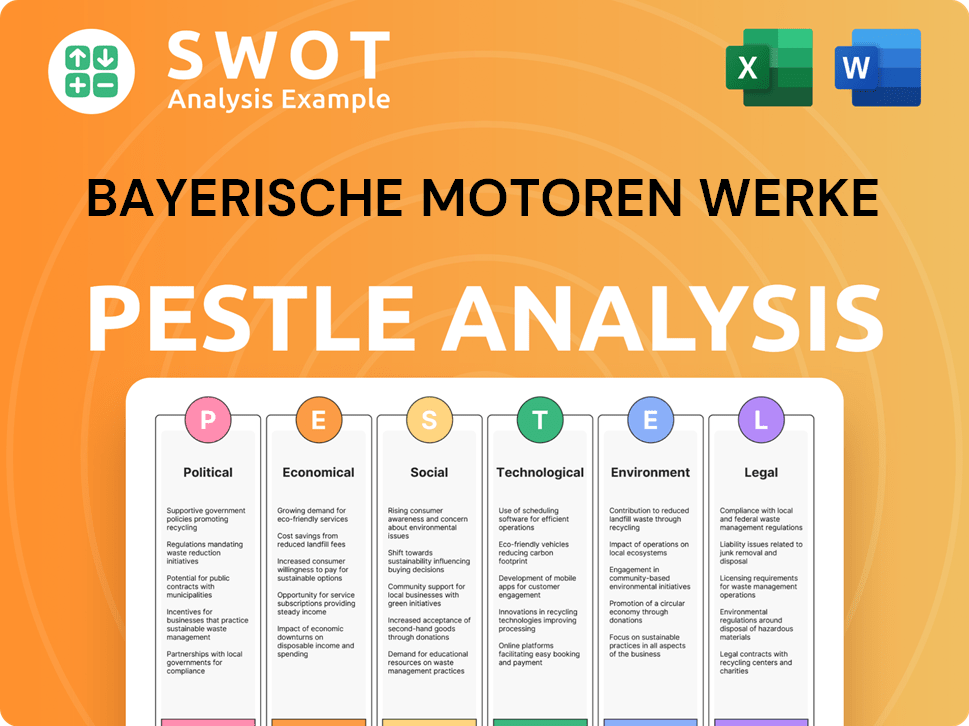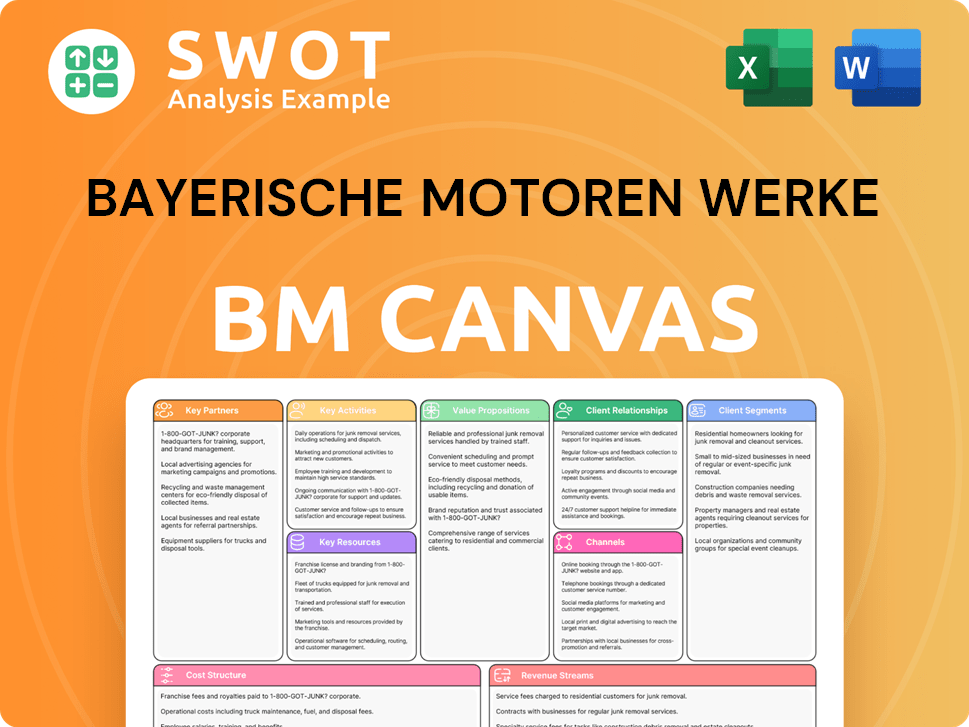Bayerische Motoren Werke Bundle
Who Really Drives the BMW Company?
Uncover the ownership secrets behind the iconic Bayerische Motoren Werke (BMW) and discover the forces that shape its future. From its humble beginnings to its global dominance, understanding the Bayerische Motoren Werke SWOT Analysis reveals how the company's ownership structure impacts its strategic decisions. Explore the intricate web of shareholders and stakeholders that steer this automotive giant.

Delving into the BMW ownership structure illuminates how the BMW company navigates the complexities of the automotive industry. Knowing who owns BMW provides crucial insights into its long-term vision and adaptability. By examining the BMW Group’s shareholder composition, we can better understand its resilience and its commitment to innovation in a competitive market. This exploration of the BMW parent company will reveal the key players influencing its trajectory.
Who Founded Bayerische Motoren Werke?
The story of Bayerische Motoren Werke (BMW) begins with its roots in several predecessor companies. Karl Rapp's 1913 founding of Rapp Motorenwerke set the stage. This company initially focused on aircraft engines, a critical early step in what would become the modern BMW.
In 1917, Rapp Motorenwerke was renamed Bayerische Motoren Werke GmbH. A year later, in 1918, it transitioned into a public company, BMW AG. Franz Josef Popp is often recognized as BMW AG's first General Director, significantly shaping the company's early direction.
Camillo Castiglioni, a key investor, played a vital role in the financial structuring that helped build the modern BMW. Early agreements centered on securing capital for production and expansion, especially as the company shifted from aircraft engines after World War I.
Karl Rapp founded Rapp Motorenwerke in 1913, which later became BMW. Franz Josef Popp was the first General Director, and Camillo Castiglioni was a major investor. These figures were crucial in the early development of the BMW company.
The early ownership of BMW involved a mix of industrialists and financial backers. Specific equity splits are complex due to the company's evolution. Early agreements were focused on securing capital for production and expansion.
Post-World War I, BMW shifted from aircraft engines, as per the Treaty of Versailles. The early vision was centered on high-quality engineering and diversified manufacturing. This laid the groundwork for BMW's future.
Franz Josef Popp and Camillo Castiglioni were key figures in the early success of the company. They held significant influence through their leadership and investments. Their contributions were essential to the initial growth and direction of BMW.
Initial capital came from established industrialists and banks. There were no prominent angel investors in the modern sense. Capital was secured to support production and expansion efforts.
The early focus on high-quality engineering was a core principle. This focus on quality was pivotal. It set the stage for BMW's reputation for premium vehicles.
Understanding the Growth Strategy of Bayerische Motoren Werke requires a look at its origins. BMW's early ownership involved key figures like Franz Josef Popp and Camillo Castiglioni. The company's evolution from aircraft engines to motorcycles and automobiles reflects a strategic shift. Early capital came from industrialists and banks. The focus on quality and diversified manufacturing was crucial.
- Karl Rapp founded Rapp Motorenwerke in 1913.
- The company transitioned to BMW AG in 1918.
- Franz Josef Popp was the first General Director.
- Camillo Castiglioni was a major investor.
Bayerische Motoren Werke SWOT Analysis
- Complete SWOT Breakdown
- Fully Customizable
- Editable in Excel & Word
- Professional Formatting
- Investor-Ready Format

How Has Bayerische Motoren Werke’s Ownership Changed Over Time?
The ownership of Bayerische Motoren Werke (BMW) has been significantly shaped by pivotal moments, particularly the enduring influence of the Quandt family. In the late 1950s, when the BMW company faced potential collapse, Herbert Quandt's strategic investment was crucial. His intervention thwarted a takeover by Daimler-Benz, securing BMW's independence and establishing the Quandt family as the dominant shareholders. This event was a turning point, solidifying their control over the BMW Group.
The evolution of BMW's ownership also includes the company's public listing on the stock exchange, which allowed for a broader base of shareholders, including institutional and individual investors. Despite this, the Quandt family has maintained a controlling interest. As of early 2024, the major stakeholders include Susanne Klatten and Stefan Quandt, children of Herbert Quandt, who collectively own approximately 46.7% of BMW's ordinary shares through their holding companies. Susanne Klatten holds 20.7%, and Stefan Quandt holds 26.0%, giving them significant influence in strategic decisions and governance.
| Stakeholder | Percentage of Shares (approx.) | Notes |
|---|---|---|
| Susanne Klatten | 20.7% | Daughter of Herbert Quandt |
| Stefan Quandt | 26.0% | Son of Herbert Quandt |
| Other Institutional and Individual Investors | Remaining Shares | Includes asset managers, mutual funds, and individual shareholders |
The remaining shares are distributed among institutional investors, mutual funds, index funds, and individual shareholders. This ownership structure, combining a strong family influence with public market participation, allows BMW to balance long-term strategic planning with market demands. This model has enabled significant investments in areas like electric vehicle technology and autonomous driving, while providing some insulation from short-term market pressures. For more insights into the company's background, you can explore a detailed Bayerische Motoren Werke company profile.
The Quandt family's influence is central to the BMW company's ownership structure, with Susanne Klatten and Stefan Quandt holding a substantial portion of shares.
- The Quandt family's investment in the late 1950s was critical in preventing a takeover and securing BMW's independence.
- BMW's public listing broadened its shareholder base but didn't diminish the Quandt family's control.
- The current ownership structure allows BMW to balance long-term strategic goals with public market demands.
Bayerische Motoren Werke PESTLE Analysis
- Covers All 6 PESTLE Categories
- No Research Needed – Save Hours of Work
- Built by Experts, Trusted by Consultants
- Instant Download, Ready to Use
- 100% Editable, Fully Customizable

Who Sits on Bayerische Motoren Werke’s Board?
The Board of Directors at Bayerische Motoren Werke (BMW) AG plays a crucial role in the company's governance. The Supervisory Board oversees the Managing Board and includes members representing both shareholders and employees, in accordance with German co-determination laws. As of early 2025, prominent members of the Supervisory Board who represent major shareholders include Stefan Quandt and Susanne Klatten, who are Vice Chairmen of the Supervisory Board. Their influence is significant in shaping the company's strategic direction. Other board members include independent experts from various industries and representatives elected by the employees.
The structure of the BMW Group reflects its unique ownership. The Quandt family's substantial ownership gives them outsized control. While there are no special voting rights or golden shares beyond the common share structure, the volume of shares held by the family ensures their ability to influence key resolutions. This includes the election of Supervisory Board members and major strategic decisions. The commitment to the company's future, particularly in areas like electromobility and digitalization, has been a consistent theme in their oversight. Understanding the Marketing Strategy of Bayerische Motoren Werke can provide further insights into the company's direction.
| Board Member | Role | Shareholder Representation |
|---|---|---|
| Stefan Quandt | Vice Chairman, Supervisory Board | Quandt Family |
| Susanne Klatten | Vice Chairman, Supervisory Board | Quandt Family |
| Other Members | Various | Independent Experts, Employee Representatives |
BMW's voting structure is primarily based on a one-share, one-vote principle for its common shares. The Quandt family's significant shareholding ensures their influence. This stability in ownership tends to foster a long-term strategic outlook, potentially reducing the likelihood of short-term driven governance controversies. The BMW company ownership structure is designed to balance shareholder interests with employee representation, a common practice in German corporations.
The Quandt family holds a substantial portion of BMW shares, ensuring significant influence over key decisions. This ownership structure provides stability and a long-term strategic focus for the BMW Group.
- Quandt family's influence on strategic direction.
- One-share, one-vote principle for common shares.
- Employee representation on the Supervisory Board.
- Focus on long-term strategic goals.
Bayerische Motoren Werke Business Model Canvas
- Complete 9-Block Business Model Canvas
- Effortlessly Communicate Your Business Strategy
- Investor-Ready BMC Format
- 100% Editable and Customizable
- Clear and Structured Layout

What Recent Changes Have Shaped Bayerische Motoren Werke’s Ownership Landscape?
Over the past few years, the ownership structure of Bayerische Motoren Werke (BMW) has remained relatively stable. The Quandt family continues to hold a significant stake, ensuring a consistent controlling influence. This stability is a key aspect of the company's strategy, providing a foundation for long-term planning and investment. Regular dividend payouts and potential share buyback programs have occurred, which can slightly alter the distribution of shares in the market, but the core ownership remains unchanged. The Competitors Landscape of Bayerische Motoren Werke shows how this ownership structure impacts its strategic decisions.
Industry trends, such as the rise of institutional investors, have also influenced BMW. Large institutional investors maintain substantial holdings, seeking long-term value. This has led to an increased focus on ESG factors and transparent reporting. While the Quandt family's stake provides stability, the influence of these institutional investors is evident in the company's strategic direction. The automotive industry has seen consolidation and strategic partnerships, but BMW has largely maintained its independence, a testament to its financial position and the family’s commitment. In 2024, institutional investors held approximately 40% of the company's shares.
| Shareholder | Approximate Percentage of Shares (2024) | Notes |
|---|---|---|
| Stefan Quandt | Around 25.8% | Key family member, significant influence. |
| Susanne Klatten | Around 19.2% | Another key family member. |
| Institutional Investors | Around 40% | Includes various investment firms. |
| Public Float | Around 15% | Shares available for public trading. |
Public statements from BMW management emphasize the company's strategic direction, particularly the shift towards electric vehicles and autonomous driving. There have been no public indications of any changes to the Quandt family's control or potential privatization. The current ownership structure supports BMW's long-term strategy, enabling it to navigate the complexities of the global automotive market with a consistent vision. BMW's commitment to its existing ownership structure is a key element in its ability to adapt to the changing automotive landscape. In 2024, BMW invested over €6 billion in research and development, reflecting its long-term strategy.
The Quandt family's continued majority stake provides stability. This helps in long-term strategic planning. It allows BMW to make significant investments.
Institutional investors hold a significant percentage of shares. They influence the company’s focus on ESG factors. Their presence encourages transparent reporting.
BMW focuses on electric vehicles and autonomous driving. The ownership structure supports this strategic shift. The company continues to innovate and invest.
BMW's financial health enables independent operations. The company consistently generates strong revenue. This allows for continued investment in the future.
Bayerische Motoren Werke Porter's Five Forces Analysis
- Covers All 5 Competitive Forces in Detail
- Structured for Consultants, Students, and Founders
- 100% Editable in Microsoft Word & Excel
- Instant Digital Download – Use Immediately
- Compatible with Mac & PC – Fully Unlocked

Related Blogs
- What are Mission Vision & Core Values of Bayerische Motoren Werke Company?
- What is Competitive Landscape of Bayerische Motoren Werke Company?
- What is Growth Strategy and Future Prospects of Bayerische Motoren Werke Company?
- How Does Bayerische Motoren Werke Company Work?
- What is Sales and Marketing Strategy of Bayerische Motoren Werke Company?
- What is Brief History of Bayerische Motoren Werke Company?
- What is Customer Demographics and Target Market of Bayerische Motoren Werke Company?
Disclaimer
All information, articles, and product details provided on this website are for general informational and educational purposes only. We do not claim any ownership over, nor do we intend to infringe upon, any trademarks, copyrights, logos, brand names, or other intellectual property mentioned or depicted on this site. Such intellectual property remains the property of its respective owners, and any references here are made solely for identification or informational purposes, without implying any affiliation, endorsement, or partnership.
We make no representations or warranties, express or implied, regarding the accuracy, completeness, or suitability of any content or products presented. Nothing on this website should be construed as legal, tax, investment, financial, medical, or other professional advice. In addition, no part of this site—including articles or product references—constitutes a solicitation, recommendation, endorsement, advertisement, or offer to buy or sell any securities, franchises, or other financial instruments, particularly in jurisdictions where such activity would be unlawful.
All content is of a general nature and may not address the specific circumstances of any individual or entity. It is not a substitute for professional advice or services. Any actions you take based on the information provided here are strictly at your own risk. You accept full responsibility for any decisions or outcomes arising from your use of this website and agree to release us from any liability in connection with your use of, or reliance upon, the content or products found herein.